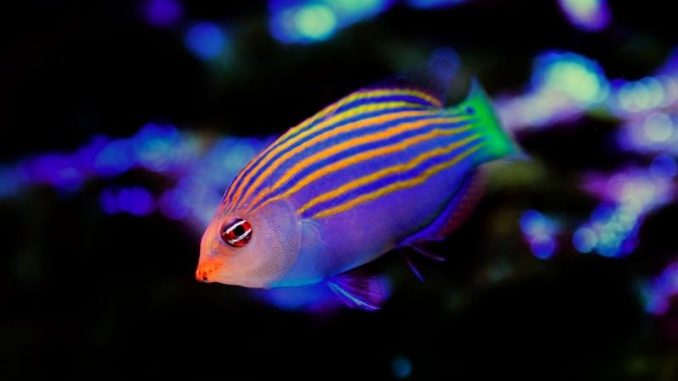
The six-line wrasse is a saltwater fish of the Labridae family. The fish is found in vivid blue or pink with bold, red horizontal stripes. The species is easy to care for due to its hardy nature. Six-line wrasses are popular amongst aquarists due to the fish’s beautiful coloring. These fish are known to be aggressive so they are not suitable for all community tanks.
TABLE OF CONTENTS
Six-Line Wrasse Facts & Overview
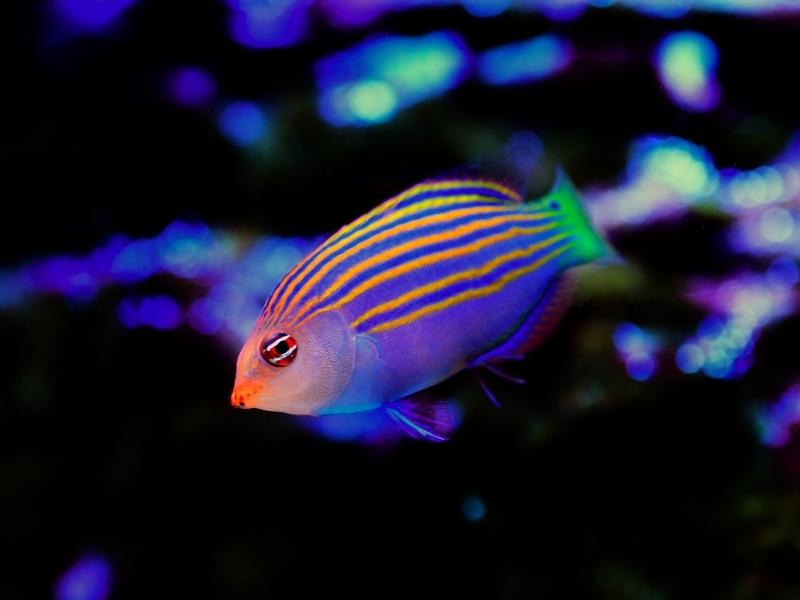
| Scientific name: | Pseudocheilinus hexataenia |
| Common names | Six-line wrasse, sixline wrasse, six bar wrasse, six stripe wrasse |
| Distribution: | The Indo-Pacific and African coast |
| Size: | Up to 3 inches |
| Life expectancy: | 4–6 years |
| Color: | Blue or pink with bold red or orange horizontal stripes |
| Diet: | Carnivore |
| Temperament: | Aggressive |
| Minimum tank size: | 30 gallons |
| Temperature: | 72–82°F (22–28°C) |
| pH: | 8.0–8.4 |
| Hardness: | 10–15 dGH |
| Care level: | Easy |
| Breeding: | Egg layer |
Origin
The six-line wrasse originates in the Indo-Pacific (notably on the coast of Fiji), as well as off the coast of Southern Africa. The fish frequents coral reefs in shallow, warm, tropical waters, and spends its days hunting for small prey animals in the cracks and crevices of the reef. Six-line wrasses are found abundantly in their natural habitat and are usually wild-caught in the aquarium trade.
Adult Size & Lifespan
Six-line wrasses are small fish, growing up to 3 inches long in the wild and in captivity. Males and females grow to the same size.
The average lifespan of a six-line wrasse is 4–6 years, depending on the quality of its environment. Some fish have been known to live for up to 10 years in captivity.
Availability
Six-line wrasses are some of the most popular saltwater aquarium fish. However, the fish are nearly impossible to breed in captivity and most fish are wild-caught. This means that, compared to similar saltwater fish, six-line wrasses are more expensive and not always in stock. The average cost of a single six-line wrasse is $30–$40.
Reputable websites that sell six-line wrasses are:
Appearance & Behavior
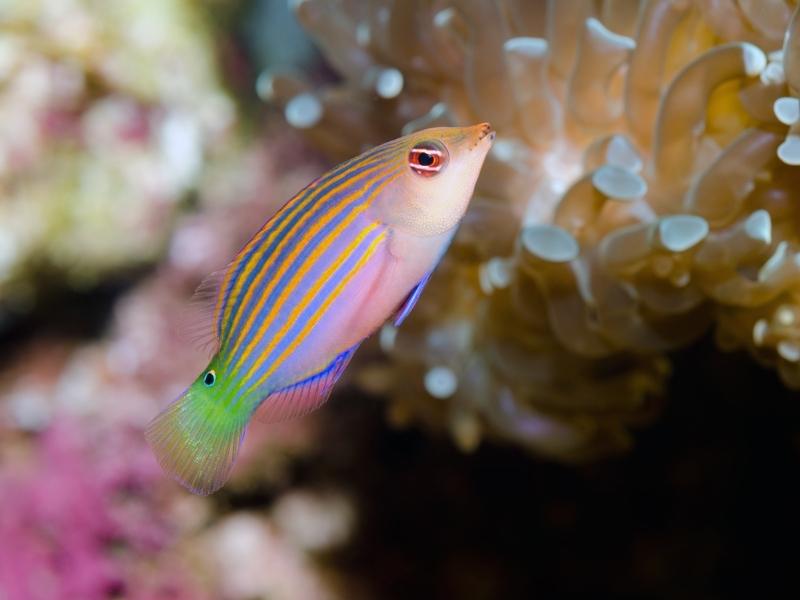
The six-line wrasse is a vibrant, colorful, active fish with an aggressive streak. As its name suggests, the fish has six horizontal lines on its body.
Colors, Patterns, Fins, and Sex Differences
The six-line wrasse has a small, banana-shaped body marked by six horizontal orange or red stripes. These fish come in bluish-purple, pinkish, and lavender colors. The fish’s tail is green or blue and a small false eye spot marks the dorsal tail peduncle. In the wild, this spot is designed to fool predators into attacking the back of the fish, giving the six-line wrasse a chance to escape.
Males and females aren’t distinguishable by color or patterns. Poor water quality and stress can cause the fish to become paler than usual.
The six-line wrasse looks similar to the blue line grouper, but the blue line grouper has darker blue fins, wavier horizontal lines, and a more orange-toned body.
Typical Behavior
Six-line wrasses are active fish with aggressive tendencies. The fish are known to chase and nip the fins of other fish when food, territory, and other resources are in short supply.
These fish are fast swimmers, inhabiting the tank’s bottom and mid-sections. The species is most active during the day, and spends its time hiding in crevices or swimming around the reef searching for food.
Six-Line Wrasse Tank Requirements
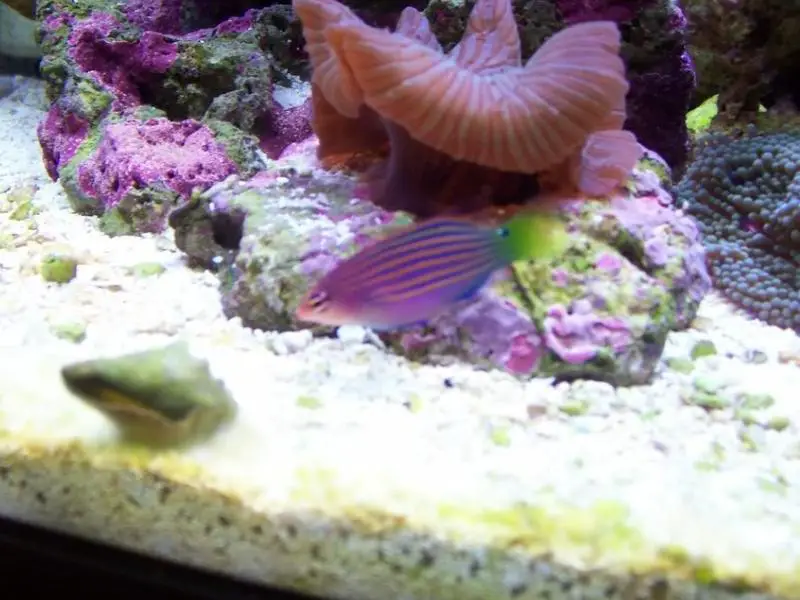
Six-line wrasses have a hardy nature, so they’re easy to care for and can survive in a wide range of water parameters. The fish are healthiest and happiest when they’re housed in a clean, spacious saltwater reef aquarium.
Habitat and Tank Setup
The natural habitats of the six-line wrasse are coral reefs in warm, shallow tropical waters. Replicate this habitat as closely as possible in the aquarium to ensure your fish is comfortable in captivity.
Six-line wrasses aren’t large fish, but they become territorial if they don’t have enough space, so a single fish needs at least a 30-gallon tank. If you plan to add different wrasse species to the tank, buy a 100-gallon or larger tank. Ensure the tank has a tight, sturdy lid because the fish are known to jump out of the water.
Live rock made from aragonite skeletons of dead corals and other organisms is ideal for a six-line wrasse tank. The fish are reef-safe and don’t nip at corals. A live rock structure will help the species feel at home, providing plenty of hiding and grazing spots.
A layer of a sandy substrate can be used to replicate the sandy reefs of the fish’s natural habitat. Driftwood, caves, and rocks can also be used to provide hiding spots in the aquarium.
Tank Conditions
Ideal tank conditions for a six-line wrasse are:
| Water type: | Alkaline, slow-moving saltwater |
| Tank size: | Minimum 30 gallons, or 100 gallons for a tank containing multiple wrasse species |
| Water temperature: | 72–82°F |
| Substrate: | Soft sand |
| Tank setup: | Live rock, caves, driftwood |
| Acidity: | 8.0–8.4 pH |
| Water hardness: | 10–15 dGH |
| Filter: | Yes, to maintain clean water conditions |
| Bubbler: | Not essential |
| Lighting: | Standard aquarium lighting |
| Water heater: | Yes, to keep the water warm |
Six-line wrasses can withstand a wider range of water parameters than most aquarium fish, so the water conditions can prioritize the needs of other fish in the tank. As long as the water remains consistently clean, the species will thrive.
Common Six-Line Wrasse Health Issues and Diseases
Six-line wrasses aren’t prone to many of the common health conditions that affect other fish in captivity. The fish may become stressed during transportation to your home, but this should resolve itself once the fish has settled in its new habitat.
Six-Line Wrasse Tank Mates
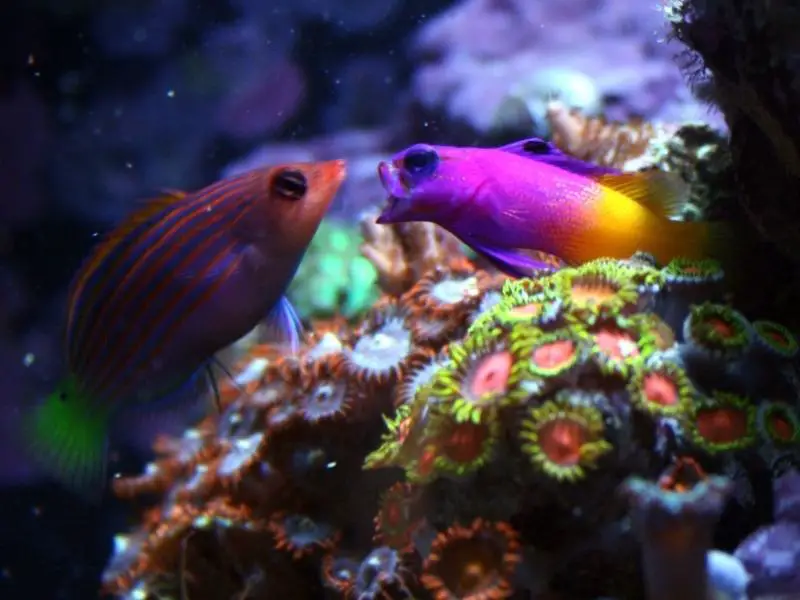
Six-line wrasses are aggressive and territorial towards other fish. Don’t house these fish with other six-line wrasses, invertebrates, or small, peaceful fish species because six-line wrasses are known to eat invertebrates and bully small fish.
Suitable tank mates for a six-line wrasse are large, confident, semi-aggressive fish, including:
- Dragon wrasses
- Banana wrasses
- Angelfish
- Butterflyfish
- Pufferfish
- Tangs
Six-Line Wrasse Diet and Feeding
In the wild, six-line wrasses eat tiny crustaceans that live in coral reefs, such as amphipods, copepods, and isopods.
A coral reef in an aquarium doesn’t provide enough food for this species, so the fish’s diet should be supplemented with a high-quality protein source, such as brine shrimp or mysis. The fish can also be weaned onto commercial fish pellets or flakes.
Feed six-line wrasses a pinch of food twice per day, providing enough food that can be eaten in two minutes. Be careful not to overfeed the fish — this can bloat the fish and affect the water quality.
Breeding the Six-Line Wrasse
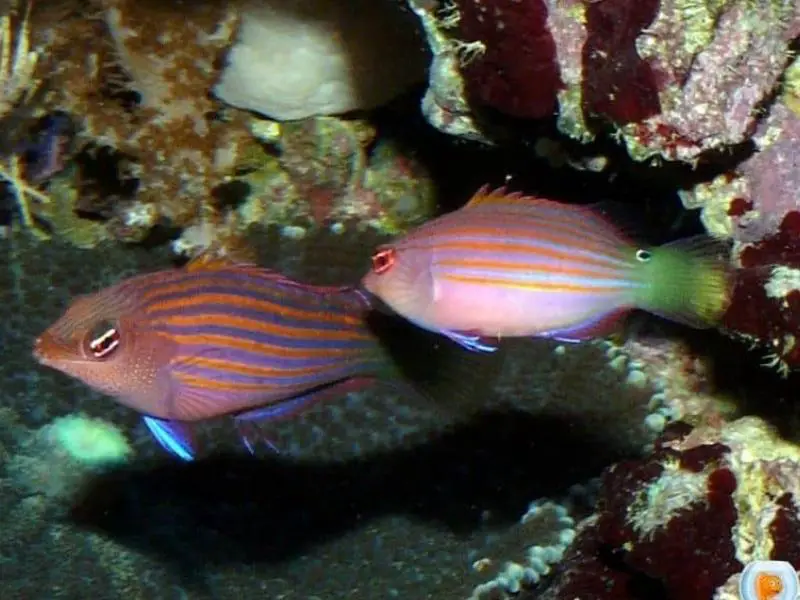
Breeding six-line wrasses in captivity are too challenging for even professional breeders to attempt, and these fish are usually wild-caught rather than bred in captivity.
Limited information about breeding six-line wrasses is available online. The species becomes sexually mature when it’s about two years old. These fish should be kept separately due to their aggressive nature, so they won’t be given the opportunity to reproduce. Also, the fish are broadcast spawners, meaning they spray their sperm and eggs randomly through the water, reducing the chance of successful fertilization.
Should You Get a Six-Line Wrasse for Your Aquarium?
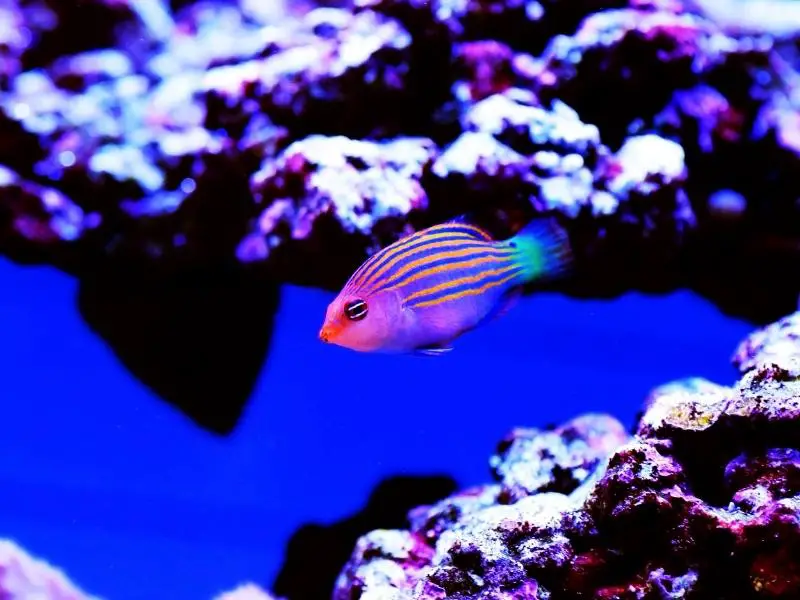
The six-line wrasse is a colorful, entertaining fish, but it isn’t suitable for all community aquariums. Consider getting this species if you have an established saltwater tank with confident, large tank mates that aren’t at risk of being bullied. Don’t get a six-line wrasse if your tank is small or contains peaceful, shy fish species.
Despite their semi-aggressive personalities and territorial behavior, six-line wrasses are beautiful fish that add vibrant color to a suitable aquarium.
Six-Line Wrasse FAQs
Are Six-Line Wrasses Reef Safe?
Yes, six-line wrasses are reef safe. The six-line wrasse’s natural habitat is coral reefs, but the fish is a carnivore and eats tiny crustaceans that live on the reef — not the reef itself. Housing six-line wrasses in a tank containing live rock is advised, to ensure the fish feels at home in captivity.
Are Six-Line Wrasses Aggressive?
Yes, six-line wrasses have an aggressive streak and are known to chase and nip the fins of their tank mates. The fish are most likely to be aggressive to other fish of their kind, or small, peaceful fish. House six-line wrasses with large, confident fish species and ensure there’s plenty of room in the tank, to reduce aggressive behavior.
How Long Do Six-Line Wrasses Live?
On average, six-line wrasses live four to six years. Some fish are known to live up to 10 years in captivity. To increase the lifespan of your fish, house the fish in a large, clean tank with plenty of hiding spots, and feed it a healthy, high-protein diet. Reduce the risk of stress and illness as much as possible by maintaining exceptional water quality.
Will a Six-Line Wrasse Eat Snails?
Yes, six-line wrasses eat snails. The fish are carnivores and are known to eat tiny invertebrates like copepods, snails, and worms. Don’t house six-line wrasses in a tank with snails because the snails will likely be eaten.
Can You Keep Two Six-Line Wrasses Together?
No, keeping two six-line wrasses together isn’t advised. The fish are territorial and aggressive, especially with fish of their kind. If you’re keen to house six-line wrasses in a community tank, choose suitable tank mates for the fish, such as angelfish, banana wrasses, and butterflyfish.
Do Six-Line Wrasses Eat Parasites?
Yes, six-line wrasses eat parasites. The fish are useful in preventing parasite problems in home aquariums because they eat small pests without damaging anemones and coral. However, you shouldn’t rely on a six-line wrasse to control a parasite issue, like ICH, in your tank. Ensure that suitable medications and tank treatments are used to kill parasites when required.

Be the first to comment